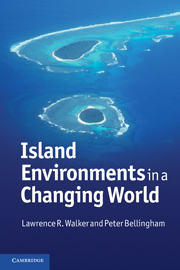Book contents
- Frontmatter
- Contents
- Preface
- Photo credits
- 1 Introduction to island environments and cultures
- 2 The physical setting
- 3 Natural disturbances on islands
- 4 The plants and animals of islands
- 5 Human dispersal, colonization, and early environmental impacts
- 6 Intensifying human impacts on islands
- 7 Islands in the modern world, 1950–2000
- 8 The future of island ecosystems: remoteness lost
- Glossary
- Index
- Plate section
- References
5 - Human dispersal, colonization, and early environmental impacts
Published online by Cambridge University Press: 05 June 2012
- Frontmatter
- Contents
- Preface
- Photo credits
- 1 Introduction to island environments and cultures
- 2 The physical setting
- 3 Natural disturbances on islands
- 4 The plants and animals of islands
- 5 Human dispersal, colonization, and early environmental impacts
- 6 Intensifying human impacts on islands
- 7 Islands in the modern world, 1950–2000
- 8 The future of island ecosystems: remoteness lost
- Glossary
- Index
- Plate section
- References
Summary
INTRODUCTION
Human settlement on the island groups relates closely to the islands' isolation. The least isolated island groups were colonized by humans earlier than remote islands. The timing of first human settlement on the island groups varies from hundreds of thousands of years ago (British Isles), to tens of thousands of years ago (Japan), to thousands of years ago (Tonga), to hundreds of years ago (New Zealand). The oldest dispersals were across land bridges to the British Isles and Japan, and the more recent were across seas by boats to all the other island groups. In this chapter, we discuss the island groups according to the chronological order in which they were settled, from the oldest to the most recent. We discuss when the islands were first settled and where the first settlers came from. We describe the landscape they encountered on arrival and where people first settled in this new landscape. We also outline what people did after they settled and what happened to the plants and animals on each of the island groups as a result.
WALKING TO BRITAIN
Startling recent discoveries from Pakefield, on the Suffolk coast in England, show that human ancestors (Homo erectus) were present in the British Isles 780 000 years ago. These discoveries date from a warm period between glacial advances and at the time the British Isles were connected by land to the rest of Europe.
- Type
- Chapter
- Information
- Island Environments in a Changing World , pp. 152 - 181Publisher: Cambridge University PressPrint publication year: 2011



